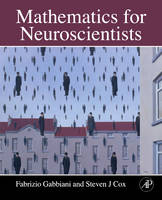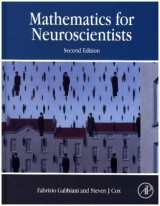
Mathematics for Neuroscientists
Academic Press Inc (Verlag)
978-0-12-374882-9 (ISBN)
- Titel erscheint in neuer Auflage
- Artikel merken
Virtually all scientific problems in neuroscience require mathematical analysis, and all neuroscientists are increasingly required to have a significant understanding of mathematical methods. There is currently no comprehensive, integrated introductory book on the use of mathematics in neuroscience; existing books either concentrate solely on theoretical modeling or discuss mathematical concepts for the treatment of very specific problems. This book fills this need by systematically introducing mathematical and computational tools in precisely the contexts that first established their importance for neuroscience. All mathematical concepts will be introduced from the simple to complex using the most widely used computing environment, Matlab.
This book will provide a grounded introduction to the fundamental concepts of mathematics, neuroscience and their combined use, thus providing the reader with a springboard to cutting-edge research topics and fostering a tighter integration of mathematics and neuroscience for future generations of students.
Dr. Gabbiani is Professor in the Department of Neuroscience at the Baylor College of Medicine. Having received the prestigious Alexander von Humboldt Foundation research prize in 2012, he just completed a one-year cross appointment at the Max Planck Institute of Neurobiology in Martinsried and has international experience in the computational neuroscience field. Together with Dr. Cox, Dr. Gabbiani co-authored the first edition of this bestselling book in 2010. Dr. Cox is Professor of Computational and Applied Mathematics at Rice University. Affiliated with the Center for Neuroscience, Cognitive Sciences Program, and the Ken Kennedy Institute for Information Technology, he is also Adjunct Professor of Neuroscience at the Baylor College of Medicine. In addition, Dr. Cox has served as Associate Editor for a number of mathematics journals, including the Mathematical Medicine and Biology and Inverse Problems. He previously authored the first edition of this title with Dr. Gabbiani.
1 Introduction 2 The Passive Isopotential Cell 3 Differential Equations 4 The Active Isopotential Cell 5 The Quasi-Active Isopotential Cell 6 The Passive Cable 7 Fourier Series and Transforms 8 The Passive Dendritic Tree9 The Active Dendritic Tree 10 Reduced Single Neuron Models 11 Probability and Random Variables 12 Synaptic Transmission and Quantal Release 13 Neuronal Calcium Signaling14 The Singular Value Decomposition and Applications15 Quantification of Spike Train Variability 16 Stochastic Processes 17 Membrane Noise18 Power and Cross Spectra 19 Natural Light Signals and Phototransduction 20 Firing Rate Codes and Early Vision21 Models of Simple and Complex Cells 22 Stochastic Estimation Theory 23 Reverse-Correlation and Spike Train Decoding 24 Signal Detection Theory 25 Relating Neuronal Responses and Psychophysics 26 Population Codes 27 Neuronal Networks 28 Solutions to Selected Exercises
| Erscheint lt. Verlag | 16.9.2010 |
|---|---|
| Verlagsort | San Diego |
| Sprache | englisch |
| Maße | 216 x 276 mm |
| Gewicht | 1600 g |
| Themenwelt | Mathematik / Informatik ► Mathematik ► Allgemeines / Lexika |
| Mathematik / Informatik ► Mathematik ► Angewandte Mathematik | |
| Naturwissenschaften ► Biologie ► Humanbiologie | |
| Naturwissenschaften ► Biologie ► Zoologie | |
| ISBN-10 | 0-12-374882-8 / 0123748828 |
| ISBN-13 | 978-0-12-374882-9 / 9780123748829 |
| Zustand | Neuware |
| Informationen gemäß Produktsicherheitsverordnung (GPSR) | |
| Haben Sie eine Frage zum Produkt? |
aus dem Bereich



